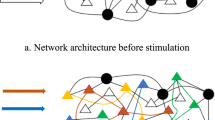Abstract
Working memory (WM) has been intensively used to enable the temporary storing of information for processing purposes, playing an important role in the execution of various cognitive tasks. Recent studies have shown that information in WM is not only maintained through persistent recurrent activity but also can be stored in activity-silent states such as in short-term synaptic plasticity (STSP). Motivated by important applications of the STSP mechanisms in WM, the main focus of the present work is on the analysis of the effects of random inputs on a leaky integrate-and-fire (LIF) synaptic conductance neuron under STSP. Furthermore, the irregularity of spike trains can carry the information about previous stimulation in a neuron. A LIF conductance neuron with multiple inputs and coefficient of variation (CV) of the inter-spike-interval (ISI) can bring an output decoded neuron. Our numerical results show that an increase in the standard deviations in the random input current and the random refractory period can lead to an increased irregularity of spike trains of the output neuron.
Access this chapter
Tax calculation will be finalised at checkout
Purchases are for personal use only
Similar content being viewed by others
References
Mongillo, G., Barak, O., Tsodyks, M.: Synaptic theory of working memory. Science 319(5869), 1543–1546 (2008)
Pals, M., Stewart, T.C., Akyürek, E.G., Borst, J.P.: A functional spiking-neuron model of activity-silent working memory in humans based on calcium-mediated short-term synaptic plasticity. PLoS Comput. Biol. 16(6), e1007936 (2020)
Ghanbari, A., Malyshev, A., Volgushev, M., Stevenson, I.H.: Estimating short-term synaptic plasticity from pre- and postsynaptic spiking. PLoS Comput. Biol. 13(9), e1005738 (2017)
Seeholzer, A., Deger, M., Gerstner, W.: Stability of working memory in continuous attractor networks under the control of short-term plasticity. PLoS Comput. Biol. 15(4), e1006928 (2019)
Tauffer, L., Kumar, A.: Short-term synaptic plasticity makes neurons sensitive to the distribution of presynaptic population firing rates. eNeuro 8(2) (2019). ENEURO.0297-20.2021
Hamaguchi, K., Riehle, A., Brunel, N.: Estimating network parameters from combined dynamics of firing rate and irregularity of single neurons. J. Neurophysiol. 105, 487–500 (2021)
Fitz, H., Uhlmann, M., van den Broek, D., Duarte, R., Hagoort, P., Petersson, K.M.: Neuronal spike-rate adaptation supports working memory in language processing. PNAS 117(34), 20881–20889 (2020)
Gallinaro, J.V., Clopath, C.: Memories in a network with excitatory and inhibitory plasticity are encoded in the spiking irregularity. PLoS Comput. Biol. 17(11), e1009593 (2021)
Gerstner, W., Kistler, W.M., Naud, R., Paninski, L.: Neuronal Dynamics: From Single Neurons to Networks and Models of Cognition. Cambridge University Press (2014)
Thieu, T.K.T., Melnik, R.: Effects of noise on leaky integrate-and-fire neuron models for neuromorphic computing applications (2022). https://doi.org/10.48550/arXiv.2202.09482
Li, S., Liu, N., Yao, L., Zhang, X., Zhou, D., Cai, D.: Determination of effective synaptic conductances using somatic voltage clamp. PLoS Comput. Biol. 15(3), e1006871 (2019)
Roberts, J.A., Friston, K.J., Breakspear, M.: Clinical applications of stochastic dynamic models of the brain, part i: a primer. Biol. Psychiatry Cogn. Neurosci. Neuroimaging 2, 216–224 (2017)
Teka, W., Marinov, T.M., Santamaria, F.: Neuronal integration of synaptic input in the fluctuation-driven regime. J. Neurosci. 24(10), 2345–2356 (2004)
Dayan, P., Abbott, L.F.: Theoretical Neuroscience. The MIT Press Cambridge, Massachusetts London, England (2005)
Acknowledgments
Authors are grateful to the NSERC and the CRC Program for their support. RM is also acknowledging support of the BERC 2022-2025 program and Spanish Ministry of Science, Innovation and Universities through the Agencia Estatal de Investigacion (AEI) BCAM Severo Ochoa excellence accreditation SEV-2017-0718 and the Basque Government fund AI in BCAM EXP. 2019/00432.
Author information
Authors and Affiliations
Corresponding author
Editor information
Editors and Affiliations
Rights and permissions
Copyright information
© 2022 Springer Nature Switzerland AG
About this paper
Cite this paper
Thieu, T.K.T., Melnik, R. (2022). Effects of Random Inputs and Short-Term Synaptic Plasticity in a LIF Conductance Model for Working Memory Applications. In: Rojas, I., Valenzuela, O., Rojas, F., Herrera, L.J., Ortuño, F. (eds) Bioinformatics and Biomedical Engineering. IWBBIO 2022. Lecture Notes in Computer Science(), vol 13346. Springer, Cham. https://doi.org/10.1007/978-3-031-07704-3_6
Download citation
DOI: https://doi.org/10.1007/978-3-031-07704-3_6
Published:
Publisher Name: Springer, Cham
Print ISBN: 978-3-031-07703-6
Online ISBN: 978-3-031-07704-3
eBook Packages: Computer ScienceComputer Science (R0)




